Day: 10 December 2024
Market Update November 2024
The Wholesale Electricity Market
Spot prices in the wholesale electricity market for November fell even further from the low levels seen the last two months. Average spot prices for the month ranged from $24 in the lower South Island (down from $50 in October), up to $35 in the upper North Island (down from $60).

The following chart shows average weekly spot prices over the last 2 years. The extreme highs and lows over the last few months can be clearly seen.
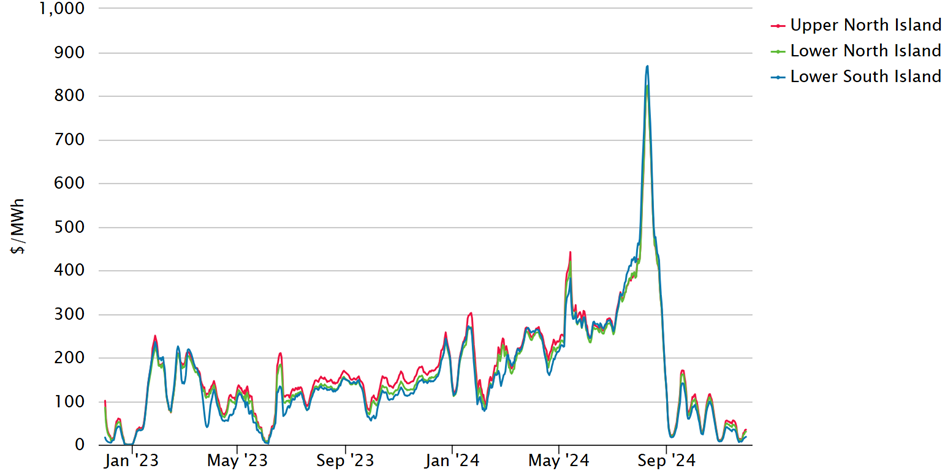
Electricity Demand
Electricity demand in November continued the recent low trend at the start of the month but increased later to be close to average in recent years later in the month.

Electricity Generation Mix
Through November, increased hydro generation for much of the month meant that thermal generation backed off even further to be close to minimal levels for most of the month.

HVDC Transfer
Power transfers on the HVDC link connecting the North and South Islands are important both in showing relative hydro positions and the reliance on thermal power to meet demand. High northward flow tends to indicate a good SI hydro position, whereas the reverse indicates a heavy reliance on thermal power to make up for hydro shortages.
With high South Island hydro storage levels, November saw continued strong northward transfers and very little southward transfer.

The Electricity Futures Market
The Futures Market provides an indication of where market participants see the spot market moving in the future. They are based on actual trades between participants looking to hedge their positions (as both buyers and sellers) into the future against potential spot market volatility. They are also a useful proxy for the direction of retail contracts.
The following graph shows Futures pricing for CY 2025, 2026, 2027 and 2028 at Otahuhu (Auckland) for the last 2 years.

Note that $100/MWh equates to 10c/kWh.
Forward prices fell again for 2025 but increased in all other years. CAL 2025 ended the month at $167.5 – down a further 9% from last month. CY 2026 price was up 2% at $181.5 while CY 2027 also closed up 2% at $174/MWh. CY 2028 finished the month up 3% at $173/MWh.
Known new generation projects are shown below (additions / removals / changes highlighted in bold).

Hydro Storage
Inflows in the South Island were again well above average in November. The North Island had a lower than average inflows for the month.

These continuing high inflows resulted in energy storage levels climbing throughout November reaching 3,891GWh (88% full) at the end of the month – an increase of 480GWh over the month. Storage is now well above the average level seen at this time of year. The following chart shows the latest breakdown of storage across the main hydro catchments.
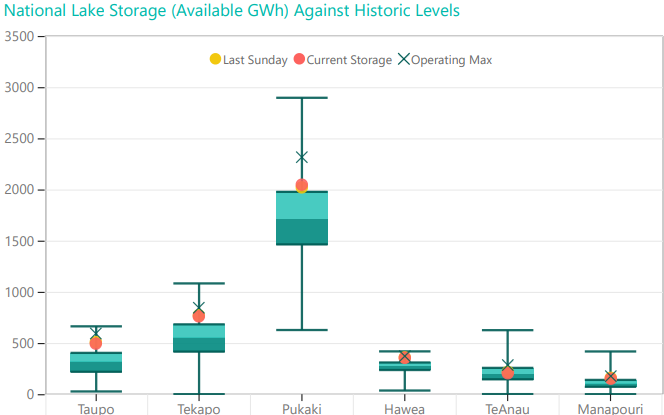
Security of supply risks decreased further through November with storage levels increasing as shown below.

Snowpack
Snowpack is an important way that hydro energy is stored over the winter months and released as hydro inflows in the spring. The following graph shows that the snowpack in the important Waitaki catchment decreased through November, however remains close to the mean levels seen in the last 30 years for this time of year.
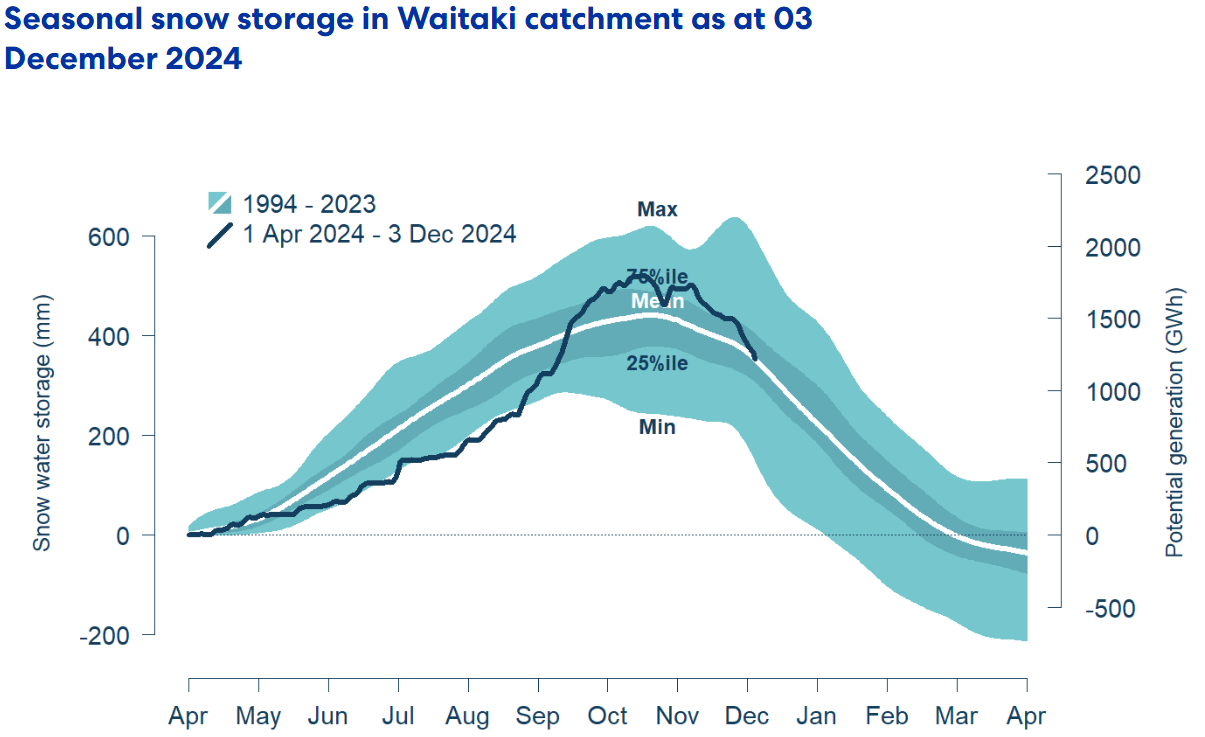
Climate outlook overview (from the MetService)
Climate drivers — An active Southern Ocean brought strongly negative (active) Southern Annular Mode (SAM) last month, driving frequent frontal passages across West Coast, Fiordland and Southland, and this uptick is likely to persist into the first week of December.
A passage of Madden-Julian Oscillation (MJO) is possible across the Southwest Pacific around mid-December, with an increased risk for tropical or subtropical cyclones north of the country. These bring the potential for significant rainfall events across the North Island if they spread southwards towards New Zealand, and with the tropical cyclone season now in effect, this will be an event to watch.
El Nino Southern Oscillation (ENSO) remains neutral, and while there is about a 1-in-3 chance for a short-lived and weak event to develop later this month into early 2025, this risk has been steadily decreasing. However, a negative Indian Ocean Dipole (IOD) event persists through much of December, which in itself can mimic La Nina conditions and heighten the risk for any northerly low to affect northern New Zealand. While the signals are not fully in alignment for development north of the country, the risk is picked to increase from about mid-month
December 2024 Outlook — Summer begins on a warm note for eastern regions across the country, with cities from Gisborne down to Oamaru expected to reach into the upper 20s to low 30s over the next few days as gusty northwesterly winds spread northwards. A few rainy days from Westland to Southland, tipping rainfall above average there, while the rest of New Zealand trends much drier under prevailing high pressure. Another weather system brings a short burst of rain across southern parts of the country to end the week.
Next week sees an unsettled start with cooler temperatures over parts of the South Island, but conditions improve markedly by mid-week as another ridge slides across New Zealand. An overall dry week again for central and northern parts of the country, trending wetter about the West Coast. A windy westerly flow is likely to accompany these weather systems which could again push temperatures near or above 30C in downwind regions. It will become important to watch for any low development north of the country later in the week with the MJO passage, and any system that develops and approaches the country could bring a risk of boom-or-bust rain event into week three, along with warmer and more humid weather.
The third week of December sees the trend for a wetter west coast of the South Island persist, while high pressure moves east of the country. This may allow a progression of fronts to cross over the country with near-average rainfall elsewhere. Temperatures are likely to trend slightly warmer than average, but a northerly low could tip the scale much warmer.
The final week of the year brings little change to the weather pattern, with hints of more settled weather possible as we head into the new year. While weather models continue picking overall dry conditions across eastern South Island and most of the North Island, the start of the tropical cyclone season means conditions north of New Zealand will become increasingly favourable for low development, and it takes only one northerly low to bring a notable rain event and push totals towards the wetter end of the scale.
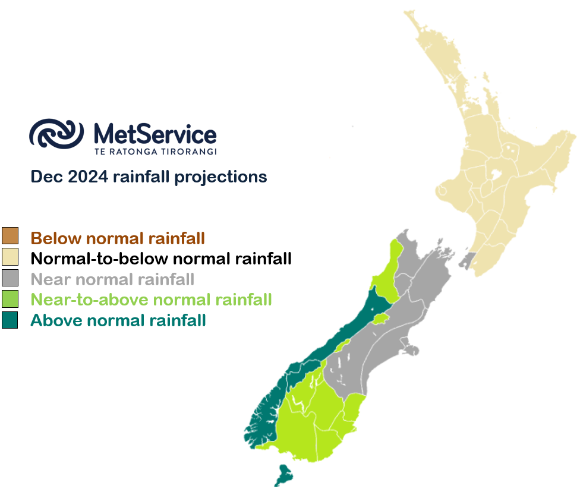
The Wholesale Gas Market
Spot gas prices in November continued at the very low levels seen over the last couple of months. Prices for the month averaged $8.65/GJ – a 5% increase compared to October. Average prices are now 36% lower than they were at the same time last year.

On the supply side Maui production fell through the month from 65TJ/day at the start of the month down to 55TJ/day by the end of the month. Pohokura maintained output, averaging around 30TJ/day. Kupe also held its output at around 42TJ/day. McKee / Mangahewa decreased its production slightly averaging 64TJ/day.
The following graph shows production levels from major fields over the last 6 years.
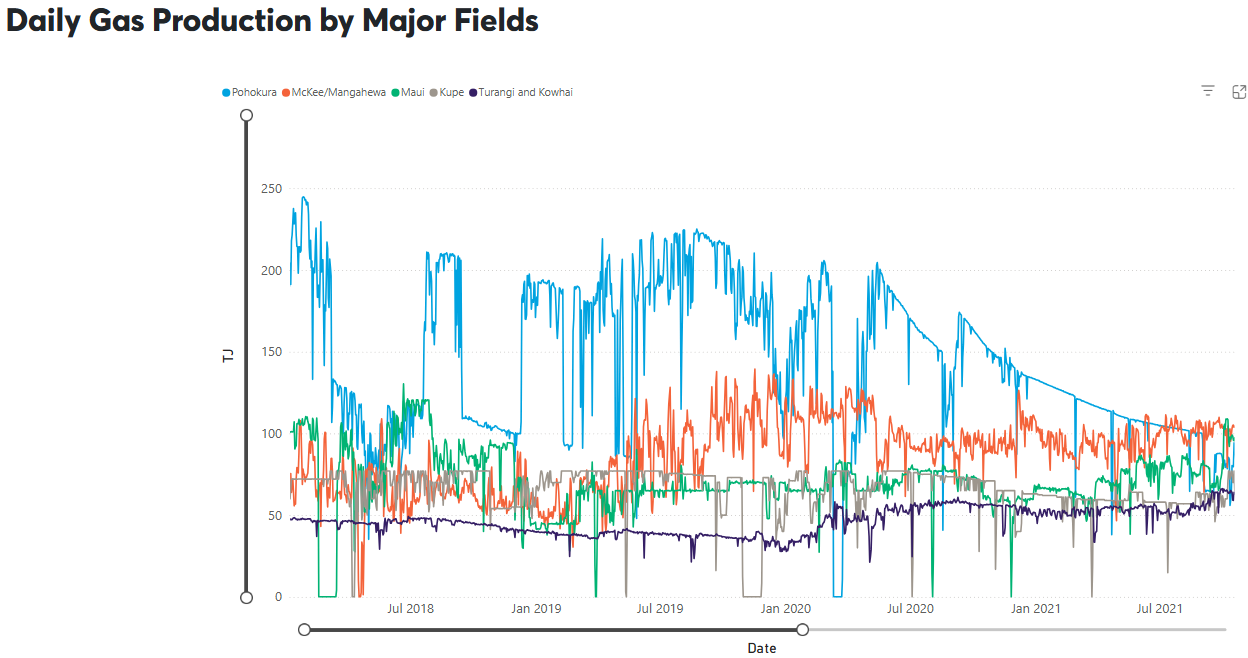
After nearly 2.5 months shutdown Methanex Motunui came back, as planned, at the very end of October. Through much of November Methanex used close to 100TJ/day. Huntly usage fell away through the month averaging 13TJ/day, while TCC remained idle for the month. There is talk that Genesis has swopped some contracted gas with Methanex, “banking” some gas for next winter.
The following graph shows trends in the major gas users over the last 6 years.

Gas storage is becoming increasingly important as falling production coincides with more variable demand particularly from gas fired electricity generation. The following chart shows how storage at Ahuroa has increased over the last few months. It is now at the highest level it has been at this time of year over the last few years.
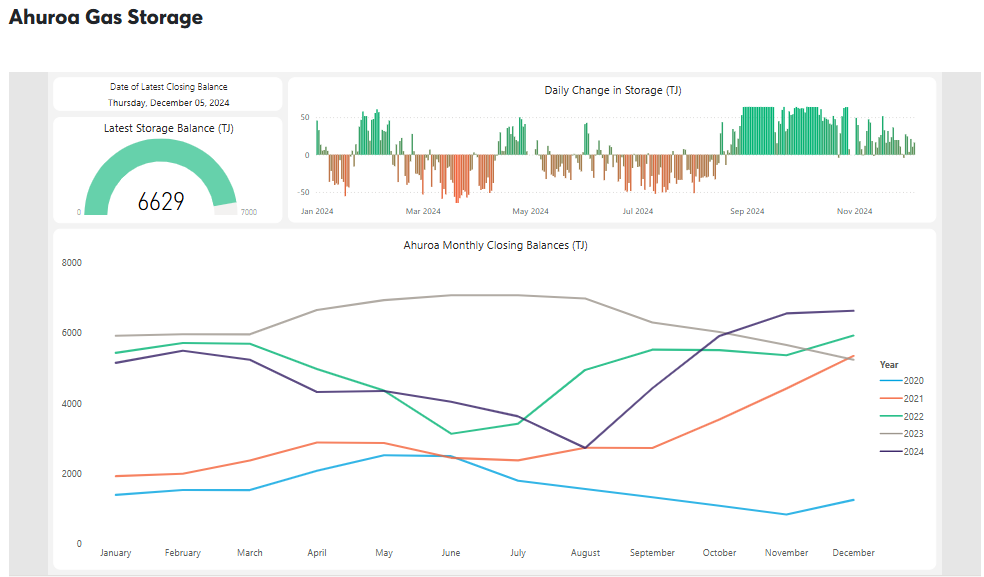
Internationally, LNG netback prices ended the month at $17.86/GJ – up 8% from last month. Forecast average price for 2024 was flat at $15.09. Forecast prices for 2025 were up 11% at $19.35/GJ. (Note that netback prices are indicative of international prices – they are produced by the ACCC and quoted in Australian dollars. They are net of the estimated costs to convert from pipeline gas in Australia to LNG, hence the term “netback”)

New Zealand does not (yet) have an LNG export/import market, so our domestic prices are not directly linked to global prices. With recent gas supply issues, the Government is now talking about the possibility of facilitating the building of an LNG import facility.
LPG is an important fuel for many large energy users, particularly in areas where reticulated natural gas is not available. The contract price of LPG is typically set by international benchmarks such as the Saudi Aramco LPG – normally quoted in US$ per metric tonne.
The following graph shows the Saudi Aramco LPG pricing for the last 3.5 years as well as forecast pricing for the year ahead. Futures pricing was flat over the last month.

The other main contributing factor to LPG prices in New Zealand is the exchange rate against the USD. The exchange rate fell through the month ending at 0.58. This would tend to push up LPG prices when quoted in NZD.
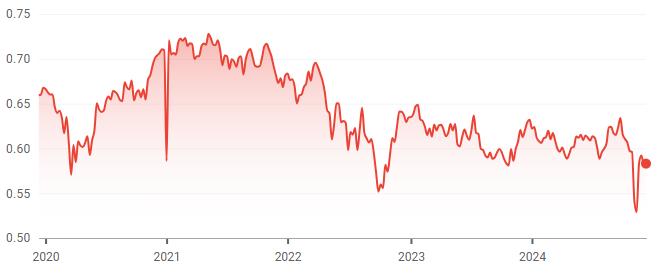
The Coal Market
The global energy crisis has been as much about coal as it has gas. The war in the Ukraine has driven energy prices, including coal, up. Prices in November fell, ending the month at US$138/T – a 3% decrease on the October close. These prices are finally returning to levels close to what we expect to see as shown in the following graph of prices over the last 10 years.

Like gas, the price of coal can flow through and have an impact on the electricity market. In October Genesis reported that it planned to import at least 270,000 tonnes of coal by March to help secure electricity supplies going into next winter. It had previously aimed to stockpile 350,000 tonnes, but now says it wants to hold about 500,000 tonnes to cover peak autumn and winter electricity demand in 2025. Genesis says that 500,000 tonnes is the equivalent of about 1,000GWh of electricity storage or 22% of maximum hydro storage in NZ.
Carbon Pricing
NZ has had an Emissions Trading Scheme (ETS) in place since 2008. It has been subsequently reviewed by several governments and is now an “uncapped” price scheme closely linked to international schemes. However, there are “upper and lower guard-rails” set up to prevent wild swings in carbon price that act as minimum and maximum prices. These increased in December 2023 to $173 and $64 respectively. Carbon prices increased 1% in November to $64.

As the carbon price rises, the cost of coal, gas or other fossil fuels used in process heat applications will naturally also rise. Electricity prices are also affected by a rising carbon price. Electricity prices are set by the marginal producing unit – in NZ this is currently typically coal or gas or hydro generators, with the latter valuing the cost of its water against the former. An increase in carbon price can lead to an increase in electricity prices in the short to medium term (as the marginal units set the price). A carbon price of $50/t is estimated to currently add about $25/MWh (or ~2.5c/kWh) to electricity prices. In the long term the impact should reduce as money is invested in more low-cost renewables and there is less reliance on gas and coal fired generation.
EU Carbon Permits increased in November to 68.4 Euro/tonne – up 2%.
About this Report:
This energy market summary report provides information on wholesale price trends within the NZ Electricity Market.
Please note that all electricity prices are presented as a $ per MWh price and all carbon prices as a $ per unit price.
All spot prices are published by the Electricity Authority. Futures contract prices are sourced from ASX.
Further information can be found at the locations noted below.
- Transpower publishes a range of detailed information which can be found here: https://www.transpower.co.nz/power-system-live-data
- The Electricity Authority publishes a range of detailed information which can be found here: https://www.emi.ea.govt.nz/
- Weather and Climate data – The MetService publishes a range of weather-related information which can be found here: https://www.metservice.com/
Disclaimer: This document has been prepared for information and explanatory purposes only and is not intended to be relied upon by any person. This document does not form part of any existing or future contract or agreement between us. We make no representation, assurance, or guarantee as to the accuracy of the information provided. To the maximum extent permitted by law, none of Smart Power Ltd, its related companies, directors, employees or agents accepts any liability for any loss arising from the use of this document or its contents or otherwise arising out or, or in connection with it. You must not provide this document or any information contained in it to any third party without our prior consent.
About Smart Power:
Smart Power is a full-service Energy Management consultancy. Apart from Energy Procurement, Smart Power can also provide:
- Technical advice on how to reduce your energy use & emissions
- Sustainability Reporting
- Invoice Management Services
We also offer boutique energy and water billing services for landlords/property developers.
Contact us here or call one of our offices to talk to our experienced staff about how we can assist you with achieving your energy goals.
© Copyright, 2024. Smart Power Ltd